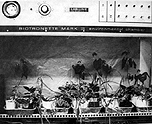About Positive Music
by Don Robertson
The Plant Experiments
In
1973, a woman named Dorothy Retallack published a small book called The Sound of
Music and Plants. Her book detailed experiments that she had been conducting at
the Colorado Woman’s College in Denver using the school’s three Biotronic
Control Chambers. Mrs. Retallack placed plants in each chamber and speakers through which
she played sounds and particular styles of music. She watched the plants and recorded
their progress daily. She was astounded at what she discovered.
Her first experiment was to simply play
a constant tone. In the first of the three chambers, she played a steady tone continuously
for eight hours. In the second, she played the tone for three hours intermittently, and in
the third chamber, she played no tone at all. The plants in the first chamber, with the
constant tone, died within fourteen days. The plants in the second chamber grew abundantly
and were extremely healthy, even more so than the plants in the third chamber. This was a
very interesting outcome, very similar to the results that were obtained from experiments
performed by the Muzak Corporation in the early 1940s to determine the effect of
"background music" on factory workers. When music was played continuously, the
workers were more fatigued and less productive, when played for several hours only,
several times a day, the workers were more productive, and more alert and attentive than
when no music was played.

|
| Dorothy Retallack and
Professor Broman working with the plants used in music experiments. |
For her next experiment,
Mrs. Retallack used two chambers (and fresh plants). She placed radios in each chamber. In
one chamber, the radio was tuned to a local rock station, and in the other the radio
played a station that featured soothing "middle-of-the-road" music. Only three
hours of music was played in each chamber. On the fifth day, she began noticing drastic
changes. In the chamber with the soothing music, the plants were growing healthily and
their stems were starting to bend towards the radio! In the rock chamber, half the plants
had small leaves and had grown gangly, while the others were stunted. After two weeks, the
plants in the soothing-music chamber were uniform in size, lush and green, and were
leaning between 15 and 20 degrees toward the radio. The plants in the rock chamber had
grown extremely tall and were drooping, the blooms had faded and the stems were bending
away from the radio. On the sixteenth day, all but a few plants in the rock chamber were
in the last stages of dying. In the other chamber, the plants were alive, beautiful, and
growing abundantly.

|
| "Chaos, pure chaos":
plants subjected to Led Zeppelin and Jimi Hendrix didn't survive |
Mrs. Retallack’s
next experiment was to create a tape of rock music by Jimi Hendrix, Vanilla Fudge, and Led
Zeppelin. Again, the plants turned away from the music. Thinking maybe it was the
percussion in the rock music that was causing the plants to lean away from the speakers,
she performed an experiment playing a song that was performed on steel drums. The plants
in this experiment leaned just slightly away from the speaker; however not as extremely as
did the plants in the rock chambers. When she performed the experiment again, this time
with the same song played by strings, the plants bent towards the speaker.
Next Mrs. Retallack tried another
experiment again using the three chambers. In one chamber she played North Indian
classical music performed by sitar and tabla, in another she played Bach organ music, and
in the third, no music was played. The plants "liked" the North Indian classical
music the best. In both the Bach and sitar chambers, the plants leaned toward the
speakers, but he plants in the Indian music chamber leaned toward the speakers the most.
She went on to experiment with other
types of music. The plants showed no reaction at all to country and western music,
similarly to those in silent chambers. However, the plants "liked" the jazz that
she played them. She tried an experiment using rock in one chamber, and "modern"
(dischordant) classical music of negative composers Arnold
Schönberg and Anton
Webern in another. The plants in the rock chamber leaned 30 to 70 degrees away from the
speakers and the plants in the modern classical chamber leaned 10 to 15 degrees away.
I spoke with Mrs. Retallack about her
experiments a few years after her book was published, and at that time I began performing
my own experiments with plants using a wood-frame and clear-plastic-covered structure that
I had built in my back yard. For one month, I played three-hours-a-day of music from
Arnold Schönberg’s negative opera Moses and Aaron, and for another month I
played three-hours-a-day of the positive music of Palestrina. The effects were clear. The
plants subjected to Schönberg died. The plants that listened to Palestrina flourished.
In these experiments, albeit basic and
not fully scientific, we have the genesis of a theory of positive and negative music. What
is it that causes the plants to thrive or die, to grow bending toward a source of sound or
away from it?
|

